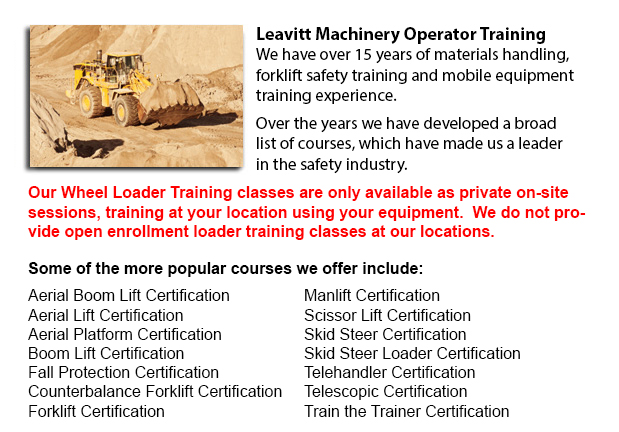
Vernon Wheel Loader Operator Training - Cranes are industrial machinery that use levers or pulleys to lift significant loads. The Romans utilized cranes in order to raise huge monuments, meaning these equipment have been existing for at least 2,000 years. Many Medieval churches utilized cranes in their creation and the Egyptian people may have utilized them when constructing the pyramids.
The modern kind of a crane can be either complex or simple, and cranes vary depending on their function. Mobile cranes, for example are quite simple. A steel truss or telescopic boom mounts its movable platform. A system of pulleys or levers lifts the boom and there is often a hook suspended. These cranes are often meant for earthmoving or demolition by changing the hook out with one more piece of device like for example a wrecking ball or a bucket. Telescopic cranes have a series of hydraulic tubes which fit together to form the boom. These models could likewise be mobile.
Traditional wheels, or particular wheels meant for a caterpillar track or railroad track allow these mobile booms to be able to navigate unpaved and uneven surfaces.
Truck mounted and rough terrain cranes are even mobile with outriggers placed on the truck mounted unit increase stability. Nonetheless, rough terrain cranes include a base which tends to resemble the bottom of a 4-wheel drive. These cranes are equipped to function on rough ground making them ideal in the construction industry for example.
Gantry cranes are actually utilized in order to move and unload big containers off of ships and trains. They are usually seen working in ports and railroads. Their bases have massive crossbeams which run on rails in order to lift containers from a spot to another. A portainer is a unique type of gantry that transports supplies onto and off of ships specifically.
Floating cranes are mounted on pontoons or barges and are one more vital piece of machinery important to the shipping industry. In view of the fact that they are places in water, they are meant for different services consisting of building bridges, salvaging ships and port construction. Floating cranes could handle really heavy loads and containers and similar to portainers, they could even unload ships.
Loader cranes consist of hydraulic powered booms that are fitted onto trailers in order to load stuff onto a trailer. The jointed parts of the boom can be folded down if the equipment is not in being utilized. This particular type of crane can be even considered telescopic as a section of the boom may telescope for more versatility.
Usually seen in automated warehouses, stacker cranes tend to follow an automated retrieval system and could operate by remote. These cranes are outfitted along with a lift truck apparatus and could be found in huge automated freezers, obtaining or stacking foodstuff. Using this particular type of system enables workers to remain out of that freezing situation.
Tower cranes, often the tallest type, typically do not have a movable base. They should be put together piece by piece. Their base resembles a long ladder with the boom perpendicular to the base. These cranes specialize in the construction of tall buildings and are often affixed to the inside of the building itself throughout the construction period.
-
Vernon Heavy Equipment Training Programs
Vernon Heavy Equipment Training Programs - At whatever given construction site, there are often different types of machinery which are ready to be used. These heavy and light machines need both operators to run them and mechanics to fix them. Trainee... More -
Vernon Forklift Safety Training
Vernon Forklift Safety Training - People wanting work in industries that operate lift trucks should undergo a forklift safety training program before becoming a certified operator of a lift truck. There are a lot of ways to go about acquiring forklif... More -
Vernon Aerial Boom Lift Ticket
Vernon Aerial Boom Lift Ticket - Aerial platform lifts can accommodate various odd jobs involving high and tough reaching places. Normally used to complete regular preservation in structures with tall ceilings, prune tree branches, elevate heavy shel... More -
Vernon Manlift Safety Training
Vernon Manlift Safety Training - Manlift operators need to be cognizant and aware of all the potential dangers which are associated with particular classes of scissor lifts. They need to be able to operate the scissor lift in a way that protects not... More -
Vernon Forklift License
Vernon Forklift License - Obtaining a forklift certification or forklift license in North America will require the one training to carry out hands-on training in addition to classroom instruction. The provincial, federal and state regulatory bodies a... More -
Narrow Aisle Forklift, Order Picker, Electric Pallet Jack, Electric Pallet Truck Certification in Vernon
A pallet lift is a model of equipment dedicated in the transporting of pallets of many dimensions and weights. They can be utilized as an appendage for forklifts, cranes and other styles of heavy machinery or be applied on their own. Pallet hoists ar... More -
Vernon Boom Lift Safety Training
Vernon Boom Lift Safey Training - Boom lifts are a type of elevated work platform or aerial lifting device which are commonly utilized in construction, industry, and warehousing. Boom lifts can be utilized in practically any surroundings because of t... More -
Vernon Manlift Operator Training
Vernon Manlift Operator Training - The aerial lift or manlift is a specialized kind of hydraulic platform that is designed to lift a person vertically giving it an alternate name of a vertical personnel lift. These machinery are widely utilized for a... More

Forklift Certification Vernon
TOLL FREE: 1-888-254-6157
Vernon, British Columbia
forkliftcertificationvernon.com
Email Us
About Us


